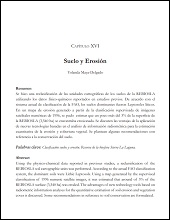Mostrar el registro sencillo del ítem
TOLERANCIA AL ESTRÉS HÍDRICO EN VARIEDADES DE ALBAHACA Ocimum basilicum L.
Tolerance to Water Stress in Varieties of Basil (Ocimum basilicum L.)
| dc.creator | CARLOS MICHEL OJEDA SILVERA | |
| dc.creator | ALEJANDRA NIETO GARIBAY | |
| dc.creator | ENRIQUE TROYO DIEGUEZ | |
| dc.creator | FRANCISCO HIGINIO RUIZ ESPINOZA | |
| dc.creator | BERNARDO MURILLO AMADOR | |
| dc.date | 2013 | |
| dc.identifier | http://cibnor.repositorioinstitucional.mx/jspui/handle/1001/1291 | |
| dc.identifier.uri | http://dspace.cibnor.mx:8080/handle/123456789/2028 | |
| dc.description | "Es importante evaluar los índices de tolerancia a la sequía de los cultivos, para recomendar a los agricultores el material vegetal más productivo cuando no se dispone de suficientes recursos hídricos. En el presente trabajo, se evaluó la tolerancia al estrés hídrico de veinte variedades de albahaca en las etapas de germinación, emergencia y crecimiento inicial, utilizando variables morfométricas. En germinación se emplearon dos tratamientos de sequía simulada con PEG-8000 con potenciales hídricos de -0.75 MPa, -1.50 MPa y agua destilada como control; en emergencia, los tratamientos consistieron en mantener el potencial hídrico del sustrato a -0.75 MPa, -1.50 MPa y un control a capacidad de campo, mientras que en crecimiento inicial se aplicó el método de la pérdida de turgencia mantenida sin llegar al punto de marchites permanente, teniendo un control con riego a capacidad de campo. En las etapas de germinación y emergencia se calcularon índices de tolerancia para altura de plántula, longitud de radícula, biomasa fresca y seca de radícula, biomasa fresca y seca de parte aérea. En el crecimiento inicial se calcularon índices de tolerancia para altura de planta, longitud de raíz, biomasa fresca y seca de raíz, biomasa fresca y seca de tallo, biomasa fresca y seca de hoja y área foliar. Al realizar un análisis de conglomerado jerárquico y de ligamiento completo sobre la base de la distancia Euclidiana, las variedades de albahaca fueron agrupadas en cuatro según los índices de tolerancia medidos en la etapa de germinación, en tres grupos con base en los índices medidos en la emergencia y en dos grupos en la etapa de crecimiento inicial, indicando la existencia de variabilidad genética en las variedades evaluadas, destacándose la variedad Dolly como la más tolerante en las tres etapas y Sweet Genovese como la más sensible al estrés hídrico." | |
| dc.description | "The evaluation of crop tolerance to drought indices are important in order to recommend the most productive crops to grow when water resources are insufficient. In this study, the tolerance to water stress of twenty varieties of basil in stages of germination, seedling emergence and early growth using morphometric variables was evaluated. In the germination stage two drought treatments were simulated with PEG-8000 with water potentials of -0.75 MPa, -1.50 MPa and distilled water as a control; during seedling emergence the treatments consisted of maintaining the water potential of the substrate at -0.75 MPa, -1.50 MPa with a control group based on irrigation at field capacity; and early growth was tested by the loss of turgor method without inflicting permanent wilting damage, the control group was determined by the water irrigation of field capacity. In the early stages of germination and emergence, tolerance was evaluated based on the rates of seedling height, radicle length, fresh and dry biomass of radicle and fresh and dry biomass of shoot. Initial growth tolerance indices were calculated for plant height, root length, fresh and dry biomass of root, fresh and dry biomass of stem, fresh and dry biomass of leaf as well as leaf area. Through the hierarchical cluster analysis of complete linkage on the basis of the Euclidean distance, varieties clustered into four groups according to tolerance indices measured at the germination stage, into three groups based on measurements of seedling emergence and into two groups based on the initial growth stage, indicating the existence of genetic variability in the varieties tested, outstanding as the most tolerant of these was the variety Dolly for the three stages, while Sweet Genovese was the most susceptible to water stress." | |
| dc.format | application/pdf | |
| dc.language | spa | |
| dc.publisher | Sociedad Mexicana de la Ciencia del Suelo A. C. | |
| dc.relation | info:eu-repo/semantics/reference/URL/URL: https://www.terralatinoamericana.org.mx/index.php/terra | |
| dc.relation | info:eu-repo/semantics/reference/ISSN/ISSN: 2395 - 8030 | |
| dc.rights | info:eu-repo/semantics/openAccess | |
| dc.rights | http://creativecommons.org/licenses/by-nc-nd/4.0 | |
| dc.source | Terra Latinoamericana | |
| dc.subject | info:eu-repo/classification/AUTOR/sequía, zonas áridas, biomasa, hierbas aromáticas | |
| dc.subject | info:eu-repo/classification/AUTOR/drought, arid zones, biomass, herbs | |
| dc.subject | info:eu-repo/classification/cti/2 | |
| dc.subject | info:eu-repo/classification/cti/24 | |
| dc.subject | info:eu-repo/classification/cti/2417 | |
| dc.subject | info:eu-repo/classification/cti/241719 | |
| dc.subject | info:eu-repo/classification/cti/241719 | |
| dc.title | TOLERANCIA AL ESTRÉS HÍDRICO EN VARIEDADES DE ALBAHACA Ocimum basilicum L. | |
| dc.title | Tolerance to Water Stress in Varieties of Basil (Ocimum basilicum L.) | |
| dc.type | info:eu-repo/semantics/article | |
| dc.type | info:eu-repo/semantics/publishedVersion |
Ficheros en el ítem
| Ficheros | Tamaño | Formato | Ver |
|---|---|---|---|
|
No hay ficheros asociados a este ítem. |
|||

